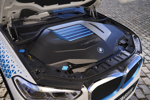With global oil reserves dwindling and prices rising, coal is already undergoing a resurgence.
But coal-powered road vehicles will not see a return of the steam cars and lorries of yesteryear.
New technology enables coal to be liquefied at an economical cost.
The resulting fuel can be used instead of petrol or diesel, with no engine adaptations needed.
The process was invented in Germany in the 1920s and used to power Panzer divisions in World War II, when the Nazis were denied oil from overseas.
Now the US, Germany, China and Australia are pushing ahead with plans to use their coal reserves to reduce their dependency on imported oil. One energy expert said the technology could be taken up by Britain, although it was less urgently needed here because the UK still had its own oil reserves.
Chris Baker, of the Energy Institute, said take-up in Britain would depend on the process's economics and the development of other potential sources of energy.
'If the price of crude oil goes up, it will probably seem to be worthwhile. It will need enormous investment to start up,' he said.
Britain still has 85% of its workable coal reserves left.
Barbara Drazga, of Energy Business Reports, said: 'Through liquefaction, or coal-to-liquids technology, solid coal can be made into liquid fuel such as gasoline or diesel and used as a substitute for petroleum products.
'Such coal-based fuels can be used directly in today's vehicles, with no need for modification. Significant air quality improvements can be achieved through the reduction of tailpipe emissions. Some studies suggest that particulate emissions may be up to 75% less than with traditional diesel.'
She said turning coal into liquid was a clean and efficient process but produced more carbon dioxide - the main greenhouse gas - than conventional oil refining. That could be offset by capturing and storing the carbon dioxide, while coal from local mines would travel shorter distances - with lower carbon emissions from transport - to the converters than most crude oil travels to refineries.
The process of making coal a car fuel
Coal is subjected to steam and oxygen to produce hydrogen and carbon monoxide.
The resulting gas, similar to natural gas, is drawn off and then condensed to form a hydrocarbon.
The hydrocarbon is processed to create the end product, such as diesel, petrol or aviation fuel.
Road fuel is distributed to filling stations where customers use it as a direct substitute for diesel or petrol from crude oil.
Carbon dioxide from processing the coal is captured and stored underground, to prevent it adding to carbon dioxide in the atmosphere.















Login to comment
Comments
No comments have been made yet.